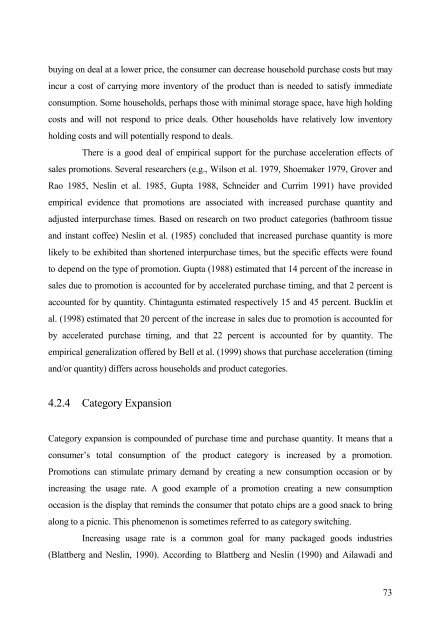Analysis of Sales Promotion Effects on Household Purchase Behavior
Analysis of Sales Promotion Effects on Household Purchase Behavior
Analysis of Sales Promotion Effects on Household Purchase Behavior
You also want an ePaper? Increase the reach of your titles
YUMPU automatically turns print PDFs into web optimized ePapers that Google loves.
uying <strong>on</strong> deal at a lower price, the c<strong>on</strong>sumer can decrease household purchase costs but may<br />
incur a cost <str<strong>on</strong>g>of</str<strong>on</strong>g> carrying more inventory <str<strong>on</strong>g>of</str<strong>on</strong>g> the product than is needed to satisfy immediate<br />
c<strong>on</strong>sumpti<strong>on</strong>. Some households, perhaps those with minimal storage space, have high holding<br />
costs and will not resp<strong>on</strong>d to price deals. Other households have relatively low inventory<br />
holding costs and will potentially resp<strong>on</strong>d to deals.<br />
There is a good deal <str<strong>on</strong>g>of</str<strong>on</strong>g> empirical support for the purchase accelerati<strong>on</strong> effects <str<strong>on</strong>g>of</str<strong>on</strong>g><br />
sales promoti<strong>on</strong>s. Several researchers (e.g., Wils<strong>on</strong> et al. 1979, Shoemaker 1979, Grover and<br />
Rao 1985, Neslin et al. 1985, Gupta 1988, Schneider and Currim 1991) have provided<br />
empirical evidence that promoti<strong>on</strong>s are associated with increased purchase quantity and<br />
adjusted interpurchase times. Based <strong>on</strong> research <strong>on</strong> two product categories (bathroom tissue<br />
and instant c<str<strong>on</strong>g>of</str<strong>on</strong>g>fee) Neslin et al. (1985) c<strong>on</strong>cluded that increased purchase quantity is more<br />
likely to be exhibited than shortened interpurchase times, but the specific effects were found<br />
to depend <strong>on</strong> the type <str<strong>on</strong>g>of</str<strong>on</strong>g> promoti<strong>on</strong>. Gupta (1988) estimated that 14 percent <str<strong>on</strong>g>of</str<strong>on</strong>g> the increase in<br />
sales due to promoti<strong>on</strong> is accounted for by accelerated purchase timing, and that 2 percent is<br />
accounted for by quantity. Chintagunta estimated respectively 15 and 45 percent. Bucklin et<br />
al. (1998) estimated that 20 percent <str<strong>on</strong>g>of</str<strong>on</strong>g> the increase in sales due to promoti<strong>on</strong> is accounted for<br />
by accelerated purchase timing, and that 22 percent is accounted for by quantity. The<br />
empirical generalizati<strong>on</strong> <str<strong>on</strong>g>of</str<strong>on</strong>g>fered by Bell et al. (1999) shows that purchase accelerati<strong>on</strong> (timing<br />
and/or quantity) differs across households and product categories.<br />
4.2.4 Category Expansi<strong>on</strong><br />
Category expansi<strong>on</strong> is compounded <str<strong>on</strong>g>of</str<strong>on</strong>g> purchase time and purchase quantity. It means that a<br />
c<strong>on</strong>sumer’s total c<strong>on</strong>sumpti<strong>on</strong> <str<strong>on</strong>g>of</str<strong>on</strong>g> the product category is increased by a promoti<strong>on</strong>.<br />
<str<strong>on</strong>g>Promoti<strong>on</strong></str<strong>on</strong>g>s can stimulate primary demand by creating a new c<strong>on</strong>sumpti<strong>on</strong> occasi<strong>on</strong> or by<br />
increasing the usage rate. A good example <str<strong>on</strong>g>of</str<strong>on</strong>g> a promoti<strong>on</strong> creating a new c<strong>on</strong>sumpti<strong>on</strong><br />
occasi<strong>on</strong> is the display that reminds the c<strong>on</strong>sumer that potato chips are a good snack to bring<br />
al<strong>on</strong>g to a picnic. This phenomen<strong>on</strong> is sometimes referred to as category switching.<br />
Increasing usage rate is a comm<strong>on</strong> goal for many packaged goods industries<br />
(Blattberg and Neslin, 1990). According to Blattberg and Neslin (1990) and Ailawadi and<br />
73

















